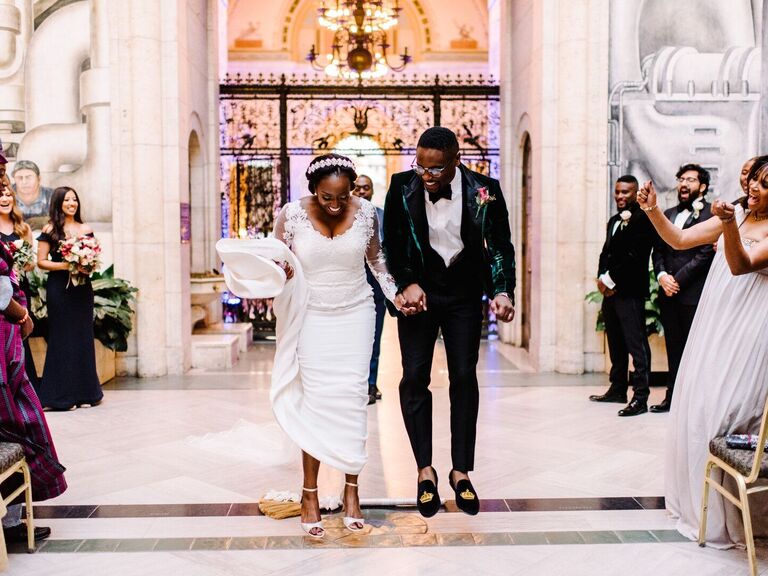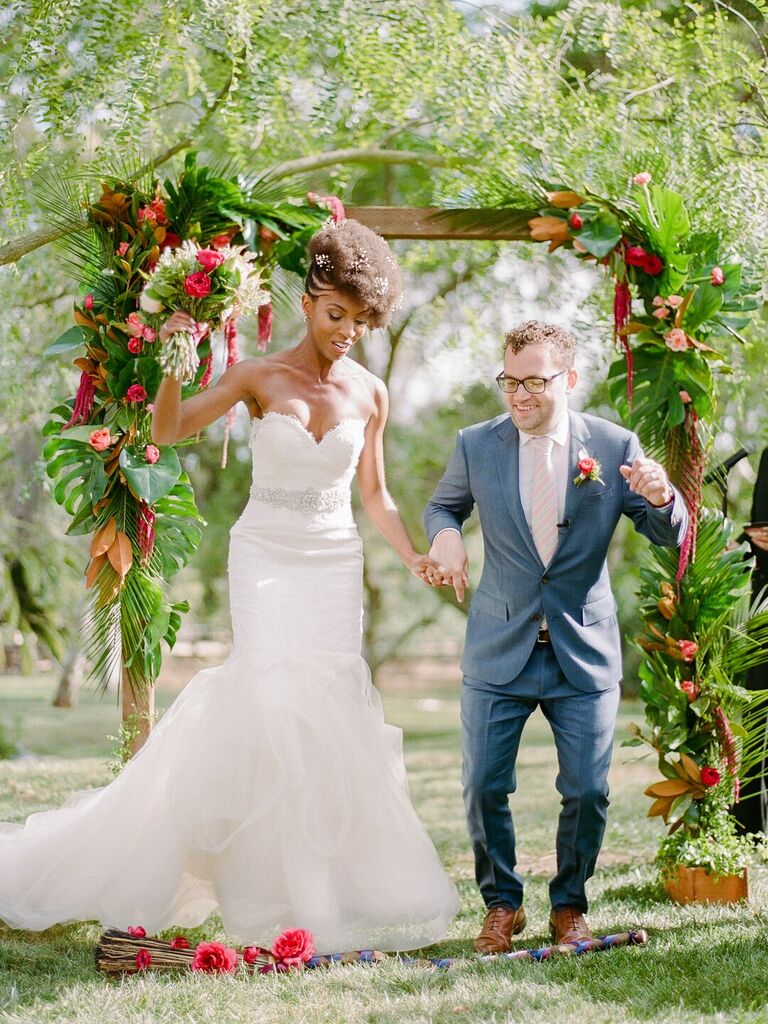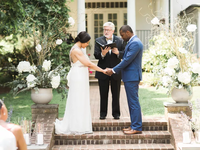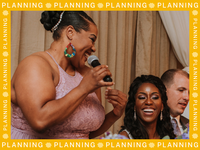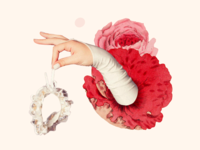Jumping the Broom: The Origin and History You Weren’t Taught
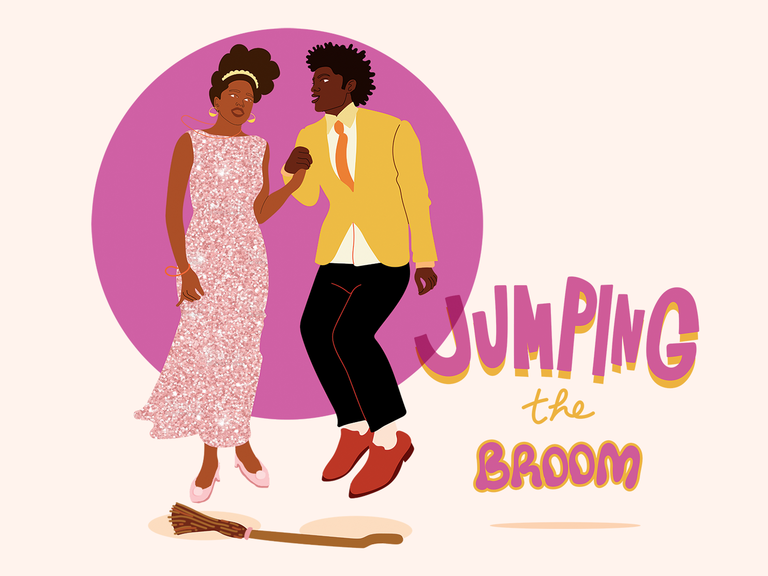
Including meaningful rituals into the wedding ceremony is a priority for lots of to-be-weds. For many Black couples, jumping the broom is one such custom. To better understand the jumping the broom ceremony, we spoke to Petronella Lugemwa, owner of Petronella Photography with more than a decade of experience, and Desireé Dent, owner of Dejanae Events for over 20 years. Keep reading to learn about the meaning, origin and more behind the jumping the broom wedding tradition.
In this article: What Is Jumping the Broom? | Meaning | Origin | History | Ceremony Planning
What Is Jumping the Broom?
Jumping the broom is a Black wedding tradition that serves as the culmination of the wedding ceremony and solidifies the couple's union. As the name suggests, during the jumping the broom wedding tradition, the couple jumps over a wedding ceremony broom that's placed on the floor at the end of the aisle. According to Lugemwa, jumping over a broom at a wedding is "done at the end of the wedding ceremony after the couple is pronounced married."
The tradition is so popular that there's a 2011 wedding movie named after it starring Paula Patton, Angela Bassett, Laz Alonso and Loretta Devine. However, including the custom isn't for everyone. To help you decide whether or not the ritual is right for you, we're taking a deep-dive into the history and meaning of jumping the broom, plus tips to keep in mind should you choose to jump the broom.
Why Do People Jump the Broom at a Wedding?
The reason people incorporate the jumping over the broom tradition today varies from couple to couple, but we can assume why some Black to-be-weds do it. Since the custom is commonly thought to be birthed by African enslaved people, some couples consider the significance of jumping the broom powerful because it allows them to honor their ancestors on such an important day. It also celebrates Black love and reclaims ownership of a ritual since some believe the tradition was created during a time when Black couples didn't have marital rights in the United States.

Jumping the Broom Meaning
What does it mean to jump the broom? According to Dent, "It not only symbolizes the sweeping away of evil, past loves and the old you, but it also represents jumping into a new life together and setting up your household."
As with many wedding traditions around the world, choosing to jump the broom at a wedding should only be done with a deep understanding of the meaning and significance it holds. Not only is it important for the couple getting married to understand the meaning, but it's also paramount that guests know the ins and outs of this unity ceremony idea so they're able to pay the ritual its proper respect. The last thing you want is guests wondering "What does jumping the broom mean?" instead of being able to fully enjoy and appreciate the moment. "To help guests understand your cultural traditions, I highly suggest offering a program to your wedding guests that explains the rituals that will take place during the ceremony. I also suggest asking the marriage celebrant to explain the traditions while performing the ceremony," says Dent.
Jumping the Broom Tradition Origin
Where did the jumping the broom tradition come from? Unfortunately, as with many multicultural wedding planning traditions, the custom's origin is often disputed. Some historians believe the custom doesn't have connections to Africa and, instead, originated in Europe. Dianne M. Stewart, a professor of religion and African American studies at Emory University, agrees in her piece about the subject and states that she's found evidence that jumping the broom made its way to America from Great Britain in the 19th century. She discovered that jumping the broom was introduced to or "seemingly imposed" on enslaved Africans by white slave owners as a pagan custom not worthy of their own unions, but ideal for Black couples "who desired a symbolic ritual."



Jumping the Broom History
According to Stewart, there are historical accounts that confirm the custom dates back to Celtic and pre-Christian Roma groups and that Welsh couples practiced broomstick weddings in the 1800s and brought the ritual with them to America, particularly to the South. Because of the custom's murky origin and most recent association with as an American wedding tradition observed by enslaved people in the South, this is most likely why most people identify African Americans as the originators of the jumping the broom ceremony.
Jumping the Broom Ceremony Planning
Even if the origins of jumping the broom aren't what you thought they would be, it's okay to include it in your ceremony program since it still has meaningful roots in Black weddings. That being said, you need to take steps to ensure you're doing the tradition justice. Below is exactly what you need to do to have a jumping the broom ceremony.
Source a Keepsake Broom
Because of the meaning associated with the ceremony, couples should think about sourcing a wedding ceremony broom that can become a keepsake to share with family members for years to come. "Many times the broom might be an heirloom passed down through the family. There are also companies that specialize in the creation of these ornate brooms," explains Dent. "The jumping broom is not your ordinary 'kitchen' variety or used to sweep floors. The jumping broom is elaborately decorated with flowers, ribbon and sometimes cowrie shells. The shells symbolize health and fertility. After the wedding ceremony has taken place, the broom is then displayed in the married couple's home to remind them of their new life together," Dent adds.
Make the Jumping the Broom Ceremony Order
Now let's talk about the wedding ceremony order. Jumping the broom takes place at the end of the ceremony after the couple says "I do." According to Dent, "The broom is placed in front of the couple, typically by a wedding party member, after they have been pronounced as married. Many times you will hear guests count '1, 2, 3' and then the couple will proceed to jump and exit the ceremony."
Have a Jumping the Broom Ceremony Script
To start the jumping the broom ceremony, have your wedding officiant provide a brief explanation to the audience about what's going to take place. You can also include a brief explanation of the custom in your wedding programs if you want guests to further understand the moment. Use the following as an example:
[Partner] and [partner] have decided to conclude their ceremony with the jumping of the broom. As the couple jumps, they cross the threshold into matrimony, which is the start of their new life together. Their action symbolizes the sweeping away of the old, welcoming in the new.
From there, the officiant will invite you to partake in the ritual. They may use some of the following wording examples as prompts: Every count…'1, 2, 3, jump' together with me: '1 ,2, 3, jump!' or Everyone, please count '1, 2, 3, jump' together with me now, and shout for joy as the couple performs their first act as newlyweds.
Pro tip: If you're looking for more ideas for your wedding ceremony script, here are some African-American wedding readings you could also include in your nuptials.
Additional reporting by Hannah Nowack



